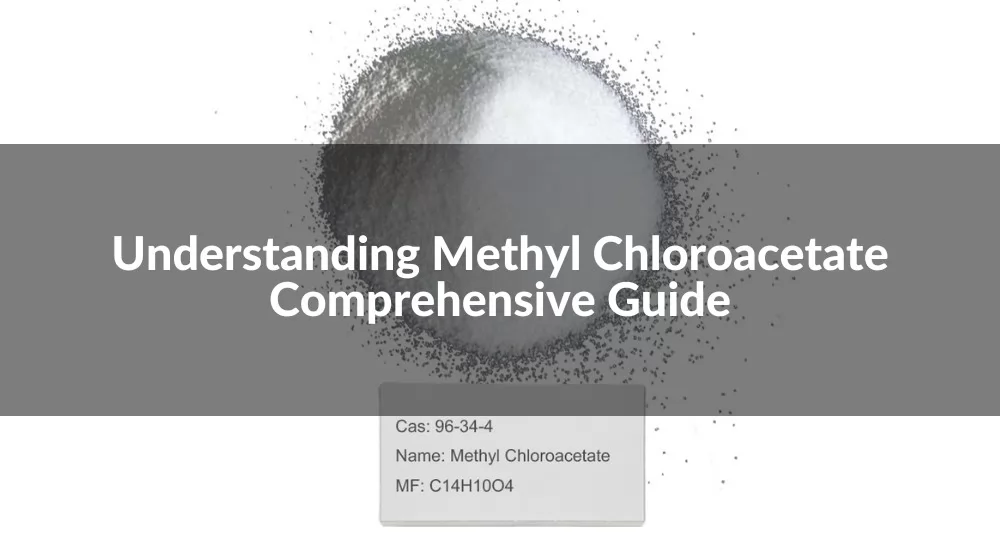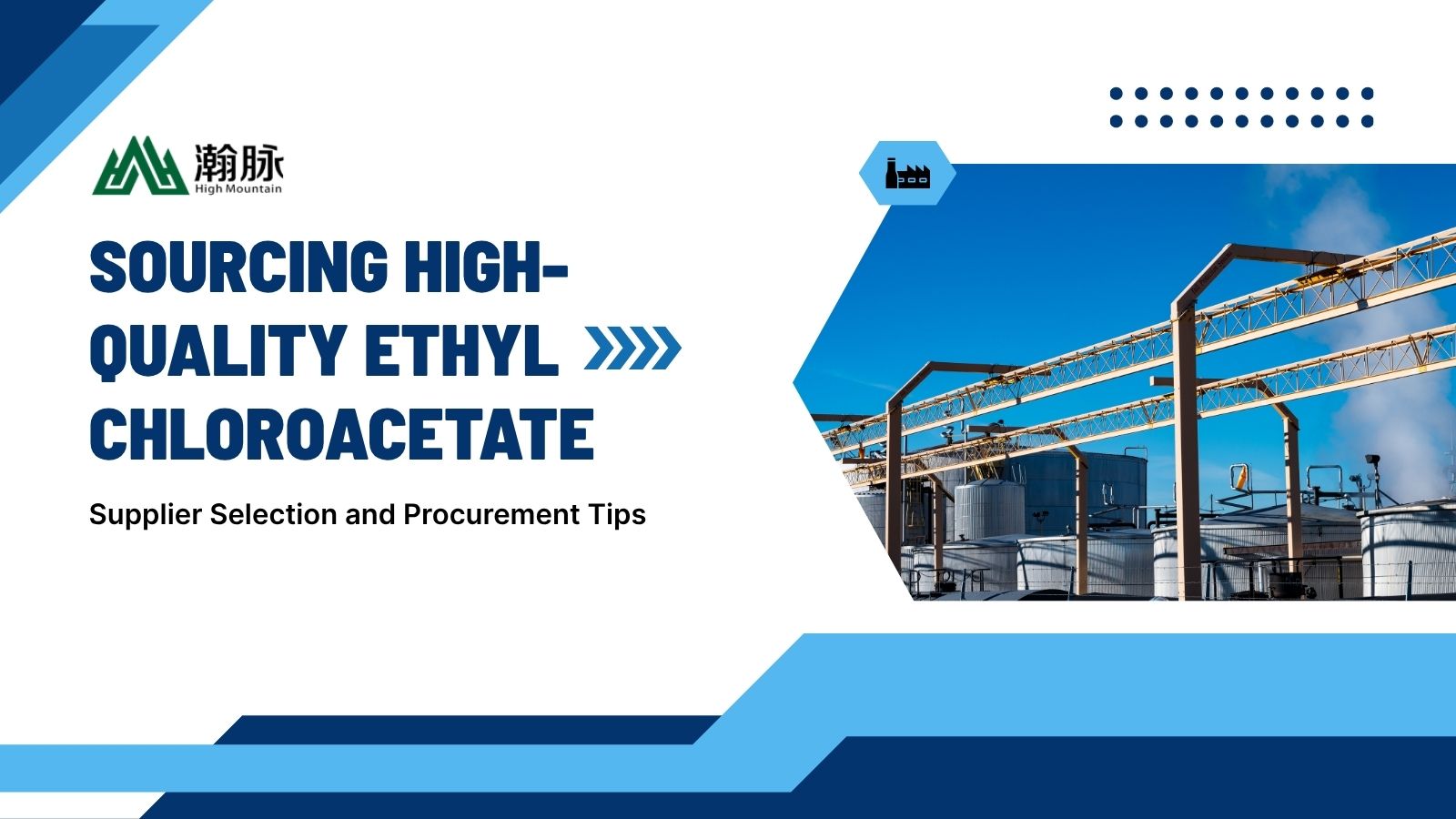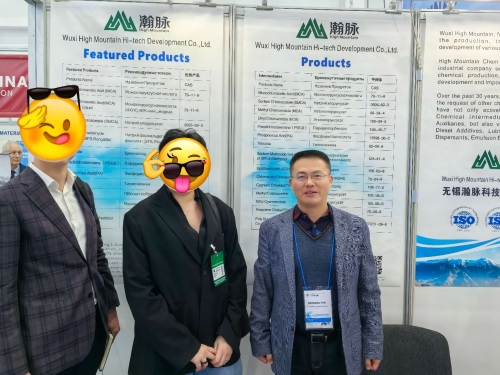

A complete resource on properties, applications, safety, and handling
Methyl chloroacetate (MCA) is a versatile organic compound with the chemical formula C3H5ClO2. As an important halogenated ester, it serves as a valuable building block in various chemical synthesis processes. This comprehensive guide aims to provide detailed information about methyl chloroacetate, including its properties, applications, safety considerations, and current market trends.
At High Mountain Chem, we recognize the significance of methyl chloroacetate in diverse industrial sectors, from pharmaceuticals to agrochemicals. This guide is designed to serve as a reliable resource for chemists, researchers, industry professionals, and students interested in understanding this compound's characteristics and applications.
Methyl chloroacetate features a relatively simple yet functionally rich structure that contributes to its chemical versatility.
The molecule consists of a methyl ester group attached to a chloroacetic acid component. The presence of both an ester group and a chlorine atom creates a compound with unique reactivity patterns:
Methyl chloroacetate exhibits characteristic reactivity patterns influenced by its functional groups:
Methyl chloroacetate is stable under normal conditions but can react with strong bases, oxidizing agents, and reducing agents. It hydrolyzes slowly in the presence of moisture, particularly under basic conditions.
Understanding the physical properties of methyl chloroacetate is essential for its practical handling, storage, and application in various processes.
| Property | Value |
|---|---|
| Physical State | Colorless liquid at room temperature |
| Odor | Fruity, ester-like odor |
| Boiling Point | 129-131°C (264-268°F) |
| Melting Point | -32°C (-25.6°F) |
| Density | 1.23 g/cm³ at 20°C |
| Solubility in Water | Slightly soluble (approximately 13.2 g/L at 20°C) |
| Solubility in Organic Solvents | Highly soluble in most organic solvents (alcohols, ethers, ketones) |
| Flash Point | 65°C (149°F) |
| Vapor Pressure | 5.3 mmHg at 25°C |
| Refractive Index | 1.4320-1.4350 at 20°C |
These physical properties make methyl chloroacetate suitable for various applications while also requiring appropriate handling and storage considerations.
Methyl chloroacetate can be synthesized through several methods, each with its advantages and limitations. Understanding these synthesis routes is crucial for industrial production and laboratory preparation.
The most common method involves the direct esterification of chloroacetic acid with methanol in the presence of an acid catalyst:
ClCH2COOH + CH3OH ⟶ ClCH2COOCH3 + H2O
This reaction typically employs sulfuric acid or p-toluenesulfonic acid as catalysts and requires removal of water (often via azeotropic distillation) to drive the equilibrium toward product formation.
Another approach involves the chlorination of methyl acetate:
CH3COOCH3 + Cl2 ⟶ ClCH2COOCH3 + HCl
This method requires careful control of reaction conditions to prevent multiple chlorination and side reactions.
Methyl chloroacetate can also be prepared from chloroacetyl chloride and methanol:
ClCH2COCl + CH3OH ⟶ ClCH2COOCH3 + HCl
This reaction proceeds rapidly and with high yield but requires handling of the corrosive chloroacetyl chloride.
On an industrial scale, continuous processes are often employed, utilizing reactive distillation or fixed-bed catalytic reactors to optimize yield and energy efficiency. Modern processes also focus on greener approaches, such as using heterogeneous catalysts and minimizing waste generation.
Methyl chloroacetate serves as a versatile chemical intermediate across numerous industries due to its reactive functional groups and relatively stable structure.
In pharmaceutical manufacturing, methyl chloroacetate is an important building block for various medicinal compounds:
The chlorine atom provides an excellent leaving group for subsequent reactions, allowing for the introduction of various functional groups relevant to pharmaceutical activity.
Methyl chloroacetate plays a significant role in the synthesis of:
In polymer science and production, methyl chloroacetate contributes to:
Although less common, methyl chloroacetate derivatives are used in the synthesis of certain flavor and fragrance compounds, particularly those requiring specific ester linkages.
In addition to its industrial applications, methyl chloroacetate is a valuable reagent in research laboratories and academic settings.
Methyl chloroacetate serves as a versatile starting material for numerous synthetic pathways:
Methyl chloroacetate reactions are often featured in undergraduate organic chemistry laboratories to demonstrate:
In analytical chemistry, methyl chloroacetate and its derivatives may be used as:
The moderate reactivity of methyl chloroacetate makes it suitable for controlled laboratory conditions, though appropriate safety measures must always be maintained.
Methyl chloroacetate requires careful handling due to its potential hazards. Proper safety measures are essential for anyone working with this compound.
When handling methyl chloroacetate, the following PPE is recommended:
In case of accidental exposure or spill:
Understanding the environmental implications of methyl chloroacetate is crucial for responsible handling and disposal practices.
When released into the environment, methyl chloroacetate undergoes several processes:
Methyl chloroacetate and its hydrolysis products can affect aquatic organisms:
To minimize environmental impact, the following practices are recommended:
At High Mountain Chem, we are committed to environmental stewardship and recommend sustainable practices for all chemicals we supply, including methyl chloroacetate.
Methyl chloroacetate is subject to various regulations globally due to its potential hazards. Understanding these regulations is essential for compliant handling, transportation, and use.
Under the Globally Harmonized System (GHS) of Classification and Labeling of Chemicals, methyl chloroacetate is typically classified as:
For shipping and transportation purposes:
Specific regulations vary by region:
Organizations handling methyl chloroacetate must typically:
High Mountain Chem provides comprehensive regulatory information with all supplied chemicals to ensure customer compliance with applicable regulations.
The global market for methyl chloroacetate continues to evolve in response to changing industrial needs, regulatory landscapes, and technological advancements.
The methyl chloroacetate market is characterized by:
Several factors are contributing to the continued demand for methyl chloroacetate:
The market also faces several challenges:
The methyl chloroacetate market is expected to:
At High Mountain Chem, we continuously monitor market trends to ensure reliable supply and competitive pricing for our customers.
Understanding how methyl chloroacetate compares to similar compounds helps in selecting the most appropriate reagent for specific applications.
| Property | Methyl Chloroacetate | Ethyl Chloroacetate | n-Butyl Chloroacetate |
|---|---|---|---|
| Boiling Point | 129-131°C | 144-146°C | 180-182°C |
| Reactivity | High | Moderate-High | Moderate |
| Solubility in Water | Slight (13.2 g/L) | Very slight (8.3 g/L) | Nearly insoluble |
| Common Applications | Pharmaceuticals, agrochemicals | Flavors, fragrances, pharmaceuticals | Coatings, specialty polymers |
| Property | Methyl Chloroacetate | Methyl Bromoacetate | Methyl Iodoacetate |
|---|---|---|---|
| Leaving Group Ability | Good | Better | Best |
| Stability | Relatively stable | Less stable | Least stable |
| Cost | Lower | Moderate | Higher |
| Handling Requirements | Moderate precautions | Stricter precautions | Extensive precautions |
Depending on the specific application, several alternatives to methyl chloroacetate may be considered:
Proper storage and transportation of methyl chloroacetate are critical for maintaining product integrity and ensuring safety throughout the supply chain.
To maintain stability and prevent hazardous situations, methyl chloroacetate should be stored according to these guidelines:
When transporting methyl chloroacetate:
Under recommended storage conditions:
At High Mountain Chem, we provide detailed storage and handling guidelines with all methyl chloroacetate shipments to ensure product integrity throughout its lifecycle.
Q: What is methyl chloroacetate primarily used for?
A: Methyl chloroacetate is primarily used as a chemical intermediate in the synthesis of pharmaceuticals, agrochemicals, and specialty chemicals. Its reactive chlorine atom and ester functionality make it valuable for introducing acetate groups into various molecular structures.
Q: Is methyl chloroacetate the same as methyl chloride?
A: No, these are different compounds. Methyl chloroacetate (ClCH₂COOCH₃) is an ester containing a chlorine atom on the alpha carbon of the acetate group, while methyl chloride (CH₃Cl) is a simple chlorinated methane molecule with different chemical properties and applications.
Q: What personal protective equipment should be used when handling methyl chloroacetate?
A: When handling methyl chloroacetate, you should wear chemical-resistant gloves (nitrile or butyl rubber), safety goggles or a face shield, a lab coat or chemical-resistant clothing, and appropriate respiratory protection if ventilation is inadequate. Always work in a well-ventilated area or under a fume hood.
Q: How should a methyl chloroacetate spill be handled?
A: For small spills, absorb with an inert material (vermiculite, dry sand, or earth), then place in an appropriate waste disposal container. For larger spills, contain the spill, ventilate the area thoroughly, collect the material with non-combustible absorbent, and dispose of according to local regulations. Always wear appropriate PPE during cleanup.
Q: What is the difference between technical grade and high-purity methyl chloroacetate?
A: Technical grade methyl chloroacetate typically has a purity of 95-98% and may contain impurities such as chloroacetic acid, methanol, and dichloroacetates. High-purity grades (99%+) have lower levels of these impurities and are used in applications requiring greater purity, such as pharmaceutical synthesis or analytical standards.
Q: Can methyl chloroacetate react with amines?
A: Yes, methyl chloroacetate readily reacts with amines through two main pathways: nucleophilic substitution at the chlorine atom to form amino acid derivatives, or aminolysis of the ester group to form chloroacetamides. The reaction pathway depends on conditions and the specific amine used.
Q: What are typical impurities found in commercial methyl chloroacetate?
A: Common impurities in commercial methyl chloroacetate include unreacted chloroacetic acid, methanol, methyl dichloroacetate, water, and hydrochloric acid. The specific impurity profile depends on the manufacturing process and purification methods used.
Q: How should the quality of methyl chloroacetate be assessed?
A: Quality assessment typically includes tests for appearance, purity (by GC or HPLC), acidity, moisture content, color (APHA/Hazen scale), and specific impurities. Additional tests may include density, refractive index, and boiling range. High Mountain Chem provides comprehensive Certificates of Analysis with each lot.
Methyl chloroacetate remains an essential chemical intermediate in various industrial sectors, particularly in pharmaceutical and agrochemical synthesis. Its versatile reactivity pattern, combining the properties of an ester and an alkyl halide, provides valuable pathways for introducing acetate functionalities and building more complex molecules.
While working with methyl chloroacetate requires appropriate safety measures and environmental considerations, its continued importance in chemical synthesis ensures its position as a staple reagent in both research laboratories and industrial processes. Understanding its properties, handling requirements, and applications is essential for anyone working with this compound.
As regulatory landscapes evolve and environmental concerns gain prominence, responsible handling and innovative applications of methyl chloroacetate will continue to develop. The chemical industry is actively researching greener approaches to its synthesis and use, reflecting the broader trend toward sustainable chemistry.
At High Mountain Chem, we are committed to providing high-quality methyl chloroacetate along with comprehensive technical support and safety information to ensure our customers can utilize this valuable chemical intermediate effectively and responsibly. Our expert team remains available to assist with any technical questions or application support needs.
High Mountain Chem is a leading supplier of specialty chemicals, including methyl chloroacetate and related compounds. With our commitment to quality, safety, and customer satisfaction, we provide reliable chemical products for research, development, and industrial applications.
For more information about our products or to request a quote, please visit www.highmountainco.com or contact our technical support team.









